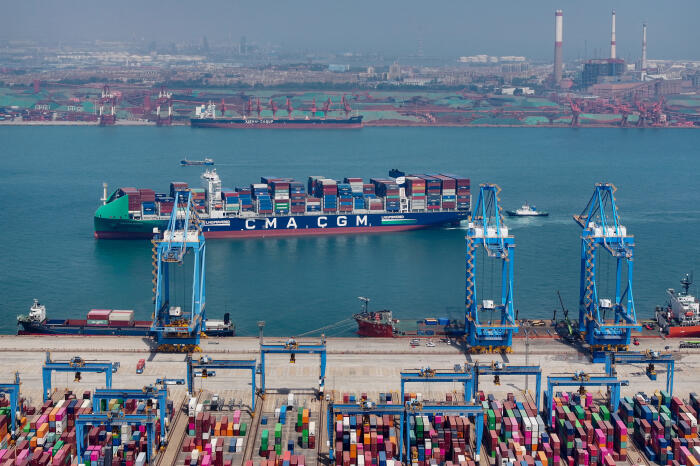The disruption of maritime traffic, linked to attacks on ships in the Red Sea, increases the cost of transport. On certain lines, experts do not exclude freight rates comparable to those of the period linked to Covid-19.
The bottom of the wave only lasted a few months for container ship owners, who paradoxically took advantage of a tense environment: the diversion of ships via the Cape of Good Hope to avoid attacks by Yemeni Houthi rebels in Red Sea lengthens journeys and therefore the number of boats to provide the same service; faced with a risk of shortage of means of transport and the disorganization of certain ports, shippers are anticipating deliveries to Europe and North America; This increase in demand leads to an increase in spot freight rates set by shipowners, and therefore their profits. All this against a backdrop of the relaunch of the tariff war between China, the United States and Europe.
Article reserved for our subscribers
“Six months ago, we envisioned 2024 looking like a walk in the desert. Now, of course, everything has changed,” summarized Peter Sand, chief analyst at Xeneta, at the ports trade fair on June 11 in Rotterdam, the Netherlands. Thus, the prices charged to manufacturers and large retailers to transport their goods – normally lower at this time of year – have jumped since the start of the year.
The average price reflected by the composite index (World Container Index) of the British firm Drewry increased from 1,400 dollars (1,310 euros) at the end of November 2023 to 4,801 dollars on June 13. On certain services between Chinese and European or American ports, they even amount to 6,000 or 7,000 dollars. The peak of $10,000 for this index, reached in September 2021, could be reached again on Asia-Northern Europe lines, warns the Bloomberg agency. The average rates are in any case much higher (+ 238%) than those of 2019, before the health crisis, recalls Drewry.
More ships and containers to provide the same service. Traumatized by the memory of the period linked to the Covid-19 pandemic, shipping company customers fear a lack of ships and bottlenecks at the end of summer, a period when large distributors are used to restock in anticipation of increased demand for consumer goods at the end of the year. In 2024, they anticipated by several months and reserved transport capacities from the end of winter. At the Rotterdam show, the head of the Danish consultancy firm Vespucci Maritime, Lars Jensen, assured that the sector finds itself “without a doubt in pandemic territory”.
Since the start of the Houthi strikes at the end of 2023, the transit of containers through the Suez Canal has been reduced by around 80%, Bloomberg Intelligence calculated. By bypassing Africa, ships take at least two weeks longer to connect Shanghai, in China, Le Havre, in Seine-Maritime, or Antwerp-Bruges, in Belgium. Read also: Article reserved for our subscribers Sea freight: “Silently, a bubble is bursting” Paris-based digital freight forwarder Ovrsea estimates that this increased the average transit time between Asia and Northern Europe by 15% between January and April. And even 39% to serve the Eastern Mediterranean. Cargoes destined for Malta, Piraeus, Greece, or Alexandria, Egypt, must, in fact, be transhipped onto other ships in Tangier (Morocco), Algeciras or Barcelona, Spain.
Le Monde Jeux Every day new crossword puzzles, Sudoku and found words. Play More ships and containers are needed to provide the same service. The re-emergence of companies operating smaller boats for transport on the high seas is a sign of strained capacities, notes a maritime transport expert. Strong restocking movement This increase in freight rates delights shipowners. Since the start of the year, the Italian-Swiss MSC, the Danish Maersk, the French CMA CGM, the Chinese Cosco and the German Hapag-Lloyd have returned to profits, even if they are incommensurate with those from 2021-2022. Read also: Article reserved for our subscribers Maritime transport: tension persists in the Red Sea CMA CGM, the world’s number three container ship, posted a net profit of 785 million dollars in the first quarter, after a loss of 90 million between October and December 2023. This return to better fortune is also due to a start to the year “more dynamic than expected for global trade in goods”, thanks to a strong restocking movement in China and the United States, explains its director financier, Ramon Fernandez. Maersk has raised its forecasts for 2024: the number two in the sector anticipates earnings before interest, taxes and depreciation of between 7 billion and 9 billion dollars (between 6.6 billion and 8.4 billion euros), higher than its previous forecast of $4 billion to $6 billion.
The threat can last for many months. De-escalation is not happening in the Red Sea. Despite the creation of an international maritime force under the aegis of the United States at the end of 2023, and patrols by several European frigates, maritime security remains precarious. The Houthis, a Shiite movement supported by Iran, claimed responsibility on Thursday June 13 for a new “military operation” against the Tutor, a Greek bulk carrier flying the Liberian flag, a sailor of which was missing. For the first time, a surface drone has reached its target, reinforcing the concerns of shipowners. Twenty-four hours later, a Polish cargo ship registered in Palau, the Verbena, was in turn struck, leading to an American response against radar sites. The confrontation could last for many months, even if the fighting in Gaza stops, according to the boss of the petroleum products transporter Frontline. “To think that ship owners will put their crews at risk by soon returning through the Suez Canal and the Gulf of Aden is a bit naive,” published Lars Barstad, Wednesday June 12, on the social network X. Read also | Article reserved for our Container ship subscribers: “Freight rates are falling but will not return to the level of recent decades”




